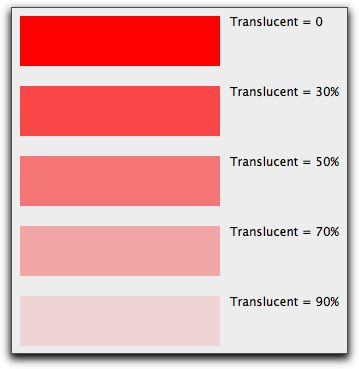HSV
From Xojo Documentation
| This item was deprecated in version 2019r2. Please use Color.HSV as a replacement. |
Returns a Color object based on the HSV (hue, saturation, value) color model with the passed level of transparency. Use the new form of the Picture constructor to create pictures that support the alpha channel or convert existing pictures to the new format using the code described in HasAlphaChannel.
Syntax
result=HSV(hue, saturation, value [, alpha = 0])
| Part | Type | Description |
|---|---|---|
| result | Color | An object that represents the color based on the hue, saturation, value, and transparency values. |
| hue | Double | The value of Hue in the color (0-1). |
| saturation | Double | The value of Saturation in the color (0-1). |
| value | Double | The value of Value (brightness or lightness) in the color (0-1). |
| alpha | Integer | The value of transparency in the color (0-255). Zero is completely opaque and 255 is fully transparent. If omitted, the default is 0. |
Notes
The HSV function returns a color object based on the amounts of Hue, Saturation, Value and Transparency (alpha channel) passed. The colors are amounts are represented by doubles between 0 and 1. Alpha is an Integer from 0-255.
Colors can also be created using the RGB or CMY models. You can also use the &c literal to specify a color using the RGB model. All alternatives support the optional transparency parameter.
Examples
This example uses the HSV function to assign a Color to the FillColor property. This code is in the Paint event of a Canvas or a Window.
Transparency
The following example draws sample color patches in a Canvas with varying levels of transparency. With the HSV function, the range is from 0 to 255. Zero is completely opaque and 255 is completely transparent. The code is in the Paint event.
g.DrawRect(0, 0, 200, 50)
g.FillRect(0, 0, 200, 50)
g.ForeColor = HSV(0, 0, 0)
g.DrawString("Translucent = 0", 210, 10)
g.ForeColor = HSV(1.0, 1.0, 1.0, 76) // transparency = 0.3
g.FillRect(0, 70, 200, 50)
g.ForeColor = HSV(0, 0, 0)
g.DrawString("Translucent = 30%", 210, 80)
g.ForeColor = HSV(1.0, 1.0, 1.0, 127) // transparency = 0.5
g.FillRect(0, 140, 200, 50)
g.ForeColor = HSV(0, 0, 0, 0)
g.DrawString("Translucent = 50%", 210, 150)
g.ForeColor = HSV(1.0, 1.0, 1.0, 178) // transparency = 0.7
g.FillRect(0, 210, 200, 50)
g.ForeColor = HSV(0, 0, 0, 0)
g.DrawString("Translucent = 70%", 210, 220)
g.ForeColor = HSV(1.0, 1.0, 1.0, 229) // transparency = 0.9
g.FillRect(0, 280, 200, 50)
g.ForeColor = HSV(0, 0, 0, 0)
g.DrawString("Translucent = 90%", 210, 290)
The result is shown here.
See Also
Color data type, CMY, RGB, SelectColor functions; &c literal.

